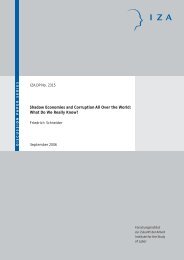Immigration: High Skilled vs. Low Skilled Labor? - Iza
Immigration: High Skilled vs. Low Skilled Labor? - Iza
Immigration: High Skilled vs. Low Skilled Labor? - Iza
You also want an ePaper? Increase the reach of your titles
YUMPU automatically turns print PDFs into web optimized ePapers that Google loves.
transferring this revenue to low-skilled native workers. The other factors would still gain<br />
(BDG), but low-skilled natives would be held harmless and would have less cause to oppose the<br />
immigration of low-skilled workers. Note that this involves treating native low-skilled workers<br />
differently than immigrant low-skilled workers, implying that immigrants would not be eligible<br />
for all or certain transfer programs (cash, housing, medical care, education, etc.).<br />
In principle, such a tax-transfer system limited to natives would be “Pareto Optimal” as<br />
no-one, whether immigrant or native, would end up worse off than before. Politically, however,<br />
it is very difficult for liberal democracies to maintain a public two-class system, and efforts to do<br />
so in principle fall apart in practice. What happens if low-skilled immigrants also receive public<br />
transfers that bring their wage rate to the original market wage rate (from W1 to W0)? The<br />
transfer BFDG to low-skilled immigrants, in addition to the transfer to low-skilled natives, more<br />
than erases the income gain to other factors of production. Now, natives as a whole lose and the<br />
total income of high-skilled workers and the owners of capital is reduced by BFD.<br />
The consequences of high-skilled immigration can also be analyzed within the context of<br />
the production function model in Figure 1. Change the axes in Figure 1 so that they now refer to<br />
high-skilled labor, and now the other factors of production are low-skilled workers and capital.<br />
The immigration of high-skilled labor lowers its wage rate, but raises the income of low-skilled<br />
labor and the owners of capital. <strong>High</strong>-skilled workers lose in terms of their wage rates (labor<br />
earnings) but gain to the extent that they are also owners of capital, if not directly, then indirectly<br />
through their pension plans. Moreover, the relative decline in their wages is not as much of a<br />
public policy concern as is the decline in the wages of low-skilled workers with low incomes.<br />
7
















